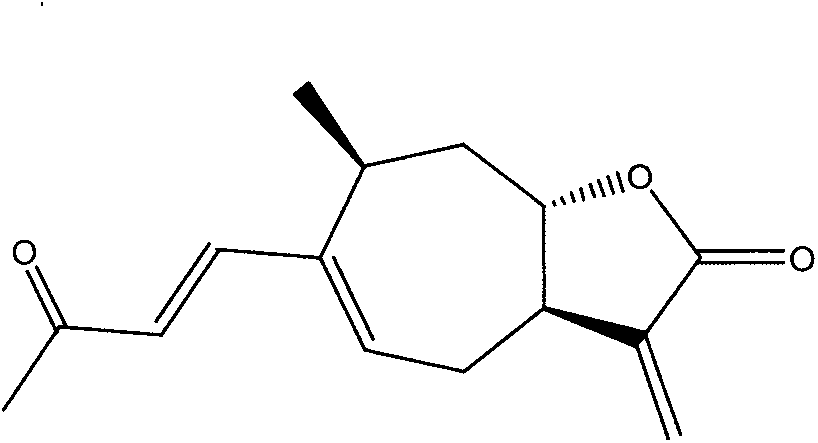Herbicide application of xanthatin extracted from Xanthium italicum
A technology of Italian cocklebur and cockleburin, applied in the direction of herbicide and algicide, application, biocide, etc.
- Summary
- Abstract
- Description
- Claims
- Application Information
AI Technical Summary
Problems solved by technology
Method used
Image
Examples
Embodiment 1
[0031] Example 1: Extracting Xanthin from Xanthium cockleburi as a herbicide
[0032] The purified Xanthin with a purity of 98% was prepared with acetone to a concentration of 1000 μg / ml, and then diluted to 10 μg / ml, 50 μg / ml, 250 μg / ml, and 1000 μg / ml. Place the filter paper in a petri dish with a diameter of 9 cm, and then add 3 ml of xanthine solution with a concentration of 10 μg / ml, 50 μg / ml, 250 μg / ml, and 1000 μg / ml respectively. After the acetone is completely volatilized, add 3ml of distilled water to each petri dish, and add 10 seeds of poison lettuce, bluegrass, camel grass and retroflexus amaranthus to each petri dish, and each treatment is repeated three times; After sealing the film, place it in a 25°C incubator and culture it in the dark for 5 days, then measure the seedling height and root length of the seedlings.
[0033] Statistical method of data: Firstly, one-way variance was used to detect whether the difference between the data of each group was signifi...
Embodiment 2
[0035] Example 2: Extracting Xanthin from Xanthium fruticosa as a herbicide and comparison of the action intensity of the commercial herbicide promethazine
[0036] METHODS: Using the above method, the commercial herbicide promethazin was also formulated into a concentration gradient of 10, 50, 250, and 1000 μg / ml, and the seeds of lettuce, bluegrass, camelus and retroflexus were cultivated at 25°C, and the seeds were grown at 25°C. After 5 days, root length and seedling height were measured for statistical analysis.
[0037] Results: Under the action of low concentration of 10μg / ml, except bluegrass, the growth of other tested plant seedlings were significantly affected, and the effect of concentration gradient appeared. When the concentration reached 50 μg / ml, the root lengths of lettuce, bluegrass, camel and amaranthus were 46%, 72%, 13% and 27% of the control; The root lengths of , bluegrass, camel and amaranthus were 41%, 66%, 6% and 17% of the control in turn. When the...
PUM
 Login to View More
Login to View More Abstract
Description
Claims
Application Information
 Login to View More
Login to View More - R&D
- Intellectual Property
- Life Sciences
- Materials
- Tech Scout
- Unparalleled Data Quality
- Higher Quality Content
- 60% Fewer Hallucinations
Browse by: Latest US Patents, China's latest patents, Technical Efficacy Thesaurus, Application Domain, Technology Topic, Popular Technical Reports.
© 2025 PatSnap. All rights reserved.Legal|Privacy policy|Modern Slavery Act Transparency Statement|Sitemap|About US| Contact US: help@patsnap.com



